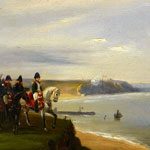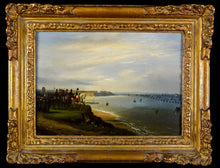Napoleon’s Camp at Boulogne, 1803-04 - Henri Toussaint Gobert (fl.1831-1881)
Adding product to your cart
Overall: 25cm (9.75in) x 31cm (12.25in)
Oil on panel. ‘View of the camp of Boulogne in 1804, Napoleon on horseback followed by his Marshalls and his Generals'. Signed ‘Gobert’ lower left . Contained in a period gilt wood frame.
Provenance:
Acquired by the Napoleon collector John Sainsbury
Exhibited at the Egyptian Hall, Piccadilly, 1843
Sold by Christie & Manson, 1845
Read more
Between 1803 to 1805 an new army of 200,000 men, known as the Armée des côtes de l'Océan (Army of the Ocean Coasts) or the Armée d'Angleterre (Army of England), was gathered and trained at camps in and around Boulogne, together with a large National Flotilla of invasion barges. The troop build up was attended by constant training exercises and ceremonial parades often in the presence of Napoleon himself. One such event included the first ever awards of the Legion’ D’Honneur. However when Napoleon ordered a large-scale trial of the invasion craft many men were drowned, causing him to seriously consider the use of a fleet of troop-carrying balloons under the command of the aeronaut Sophie Blanchard as air service chief. The invasion was finally called off, contrary to popular belief before the Battle of Trafalgar in 1805.
The present painting is possibly that described as exhibit No.38 in the exhibition of ‘Napoleonica’ held at the Egyptian Hall, Piccadilly in 1843 - on the site now occupied by Piccadilly Arcade. The exhibition of the Napoleon Museum, as it was called, was assembled by John Sainsbury, a clerical agent and Napoleonic sympathiser who began collecting in the mid in the 1820s ‘everything worth notice in a portable form relating to Napoleon’. The motivation behind his mania was to give a reply to the ‘unmeasured abuse’ which many Britons heaped on ‘the Greatest Hero of both Ancient and Modern Times’. On suffering financial difficulties, Sainsbury published the first of several catalogues and offered the collection to Sir John Soane for £6,000. When Soane demurred, Sainsbury put the collection on show (for 1 shilling a head admittance) at the Egyptian Hall. The exhibition ran for several years before dispersal by Christies, with Sainsbury publishing his magnum opus ‘The Napoleon Museum. The History of France’ in 1845.
Henri Toussaint Gobert (fl.1831-1881) was born at Boulogne in 1788 and was thus possibly an eyewitness to the massing of French forces in 1803-04 for the invasion of England. Gobert later became the director of Boulogne’s art school before 1847. The catalogue of Boulogne’s Musée des beaux-arts, published in 1860, describes another a painting by Gobert depicting Napoleon surveying his invasion force and featuring the triumphal column that was intended to commemorate the success of the invasion forces.
Sources:
(1860) ‘Notice des Tableaux exposés dans la Galerie de Peinture du Musée des beaux-arts et d'archéologie de Boulogne-sur-Mer’, Boulogne.
Sainsbury, J. (1845) ‘The Napoleon Museum: The History of France Illustrated’, London






